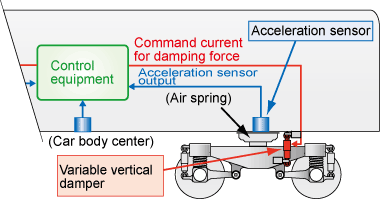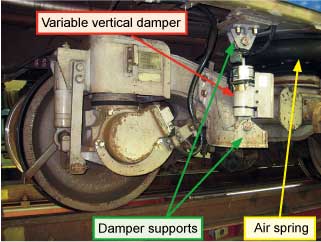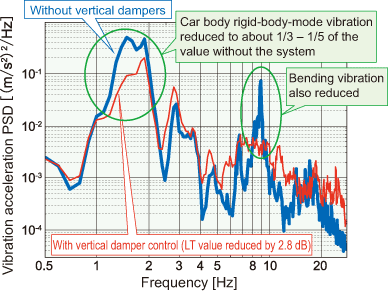1. Vertical vibration suppression system by controlling variable vertical dampers in parallel with air springs
- The RTRI developed a system of variable vertical dampers mounted in parallel with air springs to reduce car body rigid-body-mode vibration and bending vibration.
- It was confirmed in running tests that the system was effective in improving ride quality.
For vehicles running in sections with significant track irregularities, low-frequency vibration of car bodies between 1 to 2 Hz (i.e. rigid-body-mode vibration such as vertical translation, pitching, etc., which do not result in car body deformation), along with vertical vibration, significantly affect ride quality. As a method of suppressing this vibration, RTRI developed a vibration control system in which the damping force of variable vertical dampers mounted in parallel with air springs is controlled in line with car body vibration (Figs. 1, 2). These dampers also have high response characteristics in a comparatively high frequency range compared with ordinary oil dampers for railway vehicles, enabling them to cope with car body bending vibration.
The system was mounted on a meter-gauged vehicle to allow running tests. It was confirmed that the peak values of power spectral density (PSD) in the car body’s vibration acceleration could be reduced to about 1/3 – 1/5 of previous levels. In addition, the system reduces bending vibration of the car body, which is significant at the center of car bodies, by using acceleration sensors at the car body center in addition to those directly above the bogies (Fig. 3). This system reduced the LT value (a ride quality evaluation index) by up to about 3.5 dB directly above the bogies, and up to about 3 dB at the car body center, thereby demonstrating that it can improve ride quality to a certain level of sensitivity. It can also be mounted on existing vehicles by installing vertical damper supports.
 Fig. 1 Vibration control system configuration
Fig. 1 Vibration control system configuration Fig. 2 Installation of the variable vertical damper
Fig. 2 Installation of the variable vertical damper Fig. 3 Comparison of vertical vibration acceleration PSD at the car body center (result of running test: running speed 85 km/h)
Fig. 3 Comparison of vertical vibration acceleration PSD at the car body center (result of running test: running speed 85 km/h)